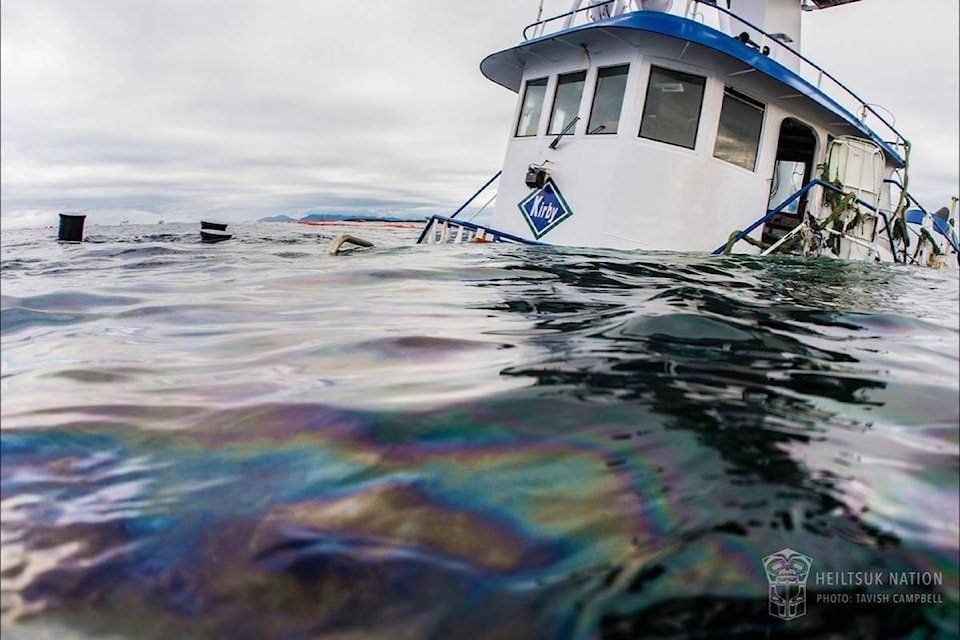When the Nathan E. Stewart went down in Seaforth Channel on October 13, 2016, the Heiltsuk people were the first to respond. They used whatever they could to try and stop the spread of the toxic fuel, but it was immediately apparent they were ill-equipped for such a massive undertaking, and the proper resources were hundreds of kilometres away.
While the B.C. government was busy promoting a “world class” spill response for projects such as the ill-fated Northern Gateway, the community of Bella Bella was changed forever, and Chief Councillor Marilyn Slett has vowed it will never happen again.
It can’t come early enough for the Heitsuk, who watched with bated breath earlier this week as another barge, this one carrying thousands of litres of fuel, came loose from its tug in rough weather and was adrift near Goose Island for almost 24 hours.
The 420-foot fuel barge Jake Shearer broke free from its tug about 45 kilometres southwest of Bella Bella. As of press time a commercial tug, the Gulf Cajun, had arrived and the barge was safely being towed out of the area.
“When the Nathan E. Stewart oil spill happened last year, we experienced first-hand what passes for a ‘world class’ spill response,” said Slett. “We waited for hours for a team to arrive, only to have them deploy defective equipment, in unfamiliar conditions, without safety gear or training for volunteer responders. As our community’s economy, environment, and way of life hung in the balance, we promised ourselves this would never happen in our territory again.”
The Heiltusk have since released a report entitled Creating a World-Leading Response Plan, which outlines plans to take to strengthen oil spill prevention and clean-up on the central coast by establishing an Indigenous Marine Response Centre (IMRC).
The report was prepared by experts in marine safety and engineering, and shares priorities outlined in the federal government’s 2016 Canada’s Oceans Protection Plan (OPP). In particular, the IMRC plan shares the OPP’s focus on indigenous-led responses and dedication to “a world-leading marine safety system that improves responsible shipping and protects Canada’s waters, including new preventive and response measures”.
The IMRC will be located in Heiltsuk territory where 80 per cent of incidents in the study area occur and staffed by trained crew familiar with the local marine environment. It will be equipped with vessels and equipment expressly designed for central coast conditions and have the capacity respond to 100 per cent of incidents in the study are in five hours or less.
The report says the proposed centre, on Denny Island across from Bella Bella, and satellite operations dotted along the central coast, would need a total investment of $111.5 million to be operational by next summer.
Unlike current response programs which the report says are limited specifically to spills, the new centre would answer all marine calls with the potential for oil contamination, including groundings, fires, bottom contacts and capsizings.
“(The centre’s) effectiveness hinges on a fleet of fast response vessels capable of oil clean up and containment, and a tug and barge system providing storage and additional oil spill clean-up capabilities,” the report says.
The barge would also be equipped with enough safety gear, provisions and living space to allow a response team to remain on site for up to three weeks without outside support.
The marine response centre would have annual operating costs of $6.8 million, covering a full-time staff and crew of 37.
“From Ahousaht with the Leviathan II to Gitga’at with the Queen of the North to Heiltsuk with the Nathan E. Stewart, Indigenous communities have shown that we are and will continue to be the first responders to marine incidents in our waters,” says the report, signed by Slett and hereditary Chief Harvey Humchitt.
Indigenous rescuers were first on the scene when six people died after the whale-watching vessel the Leviathan II capsized north of Tofino in 2015. Two people were killed when the Queen of the North hit an island and sank in 2006 west of Hartley Bay and First Nations helped in the rescue.
“The time has come to meaningfully develop our capacity to properly address emergencies in our territories as they arise,” the report says.
The Heiltsuk’s plan dovetails with the federal OPP, which states the government “will partner with Indigenous and coastal communities to develop a world-leading marine safety system that meets the unique needs of Canada from coast-to-coast-to-coast.”
“Heiltsuk have been protecting and stewarding our territory since time immemorial,” says Hereditary Chief Harvey Humchitt. “This proposal is a natural evolution of that work, and builds on the best available local knowledge and technology. We look forward to implementing this with the support of all other levels of government and our neighbours. We do this not only for Heiltsuk, but for all who travel within and through our territories.”
The Heiltsuk release stated that with an initial investment of $11 million by January 1, 2018, the IMRC’s base operations, fleet, and crew could be in effect by summer 2018.
